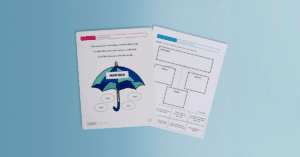We shared a review of articulation approaches, and now we’re diving into a case study for the Complexity Approach.
Why the Complexity Approach?
Jennifer Taps Richard does a great job explaining why we might want to use this approach.
“Children who are taught complex sounds often learn treated and untreated sounds due to the relationships amongst sounds. For example, if a child is missing many sounds and is taught a three-element cluster (e.g., /str‐/), it is predicted that he or she will also learn some missing two-element clusters, affricates, fricatives, and stops. Conversely, if a child is missing many sounds and is taught a stop (e.g., /k/ or /g/), it is predicted that /k/ or /g/ will likely change, but not other sounds. Teaching complex sounds leads to rapid change and gains in intelligibility.”
She makes these claims based on a strong evidence base.
Note: I learned so much about the Complexity Approach from Jennifer Taps Richard at SLPath.com. She offers so many free evidence-based resources, and her courses are incredibly helpful.
A Case Study for the Complexity Approach
Sophie is a five-year-old preschooler.
She scored in the 1st percentile (Standard Score = 63) on the Goldman-Fristoe Test of Articulation (GFTA-3).
She consistently produces the following sounds: bilabials /p, b, m, w/, alveolars /t, d, n/, velar /k/, and fricative /f/.
The produced errors on the following sounds: velar /g, ŋ/, fricatives /v, ʃ, θ, ð/, liquids /l, r/, and affricates /ʧ, ʤ/. She is stimulable for the following sounds: /l, ʃ, ʒ, θ, ð/.
She produces all sounds for 78% of blends/clusters, however, she consistently substitutes /w/ for /l/ and /r/.
Phonological processes include gliding (75% of productions), stopping (33% of productions), stridency deletion (24% of productions), vocalization (93% of productions), palatal fronting (58% of productions), velar fronting (17% of productions), and cluster reduction (22% of productions).
Sophie’s speech is difficult to understand. Her parents understand 70% of what she says, but unfamiliar listeners rate Sophie’s intelligibility as low as 50%.
Sample Target Selection for the Complexity Approach
I used the Phonological Assessment and Treatment Targets Analysis Forms (Barlow, Storkel & Taps, 2010) that Jennifer Taps Richard offers on her site (for free!).
I followed the steps and identified the following targets:
1. “spl-”
• I chose this target because three-element clusters imply two-element /s/-clusters and two‐element non-/s/-clusters (Gierut & Champion, 2001). By working on this complex cluster, we may influence broader changes across Sophie’s system. She may independently acquire the other sounds/clusters as a result of working on this cluster.
• It is a possible target because Sophie is able to produce all three sounds in the cluster.
2. “shr-” and “thr-”
• I chose these targets because (1) clusters imply affricates, (2) clusters imply singletons, (3) fricative and liquid clusters imply stop clusters, and (4) clusters with a small sonority difference imply clusters with a large sonority difference (Gierut, 2007). By targeting these targets, we can potentially make significant changes to Sophie’s speech sound system without having to target all of the sounds individually.
* Note: I know this might sound kind of crazy! I have been able to work through these targets with preschoolers, and (yes!!) I did see these implicational laws in action.
Sample Goals for the Complexity Approach
Sophie will independently produce “spl-”, “thr-“, and “shr-” in words with 80% accuracy.
Shophie will produce 80% of consonants in words as measured by an independent singleton probe.
Sophie will produce 80% of consonants in words as measured by an independent clusters probe.
Sophie will increase her overall intelligibility to 80% in conversation as measured by conversation samples collected three times per year.
Sample Activities for the Complexity Approach
Jennifer Taps Richards offers a variety of free activities on her site.
If you’re looking for more materials, SLP Now has a Complexity Starter Kit (including cards and activity pages for each of the clusters).




Thanks so much for sharing. This information was layed out in a way that was easy to follow :).
My question is how long did it take for Sophie (or similar clients) to reach these goals?
That is such a great question! I wish I had a better answer, but it varies so much for each student. The particular student gained about 15% on the Percent Consonants Correct inventory every quarter. We spent 4-6 weeks on each cluster, but we also targeted other language goals. I am definitely keeping my eyes peeled for more research/data to answer this question!!
Are there any suggestions on when to use Cycles versus the Complexity Approach? Or is it a matter of comfort?
That is such a great question! This article doesn’t discuss the cycles approach specifically, but I think the discussion is super helpful: https://www.theinformedslp.com/qa_complexity_approach.html